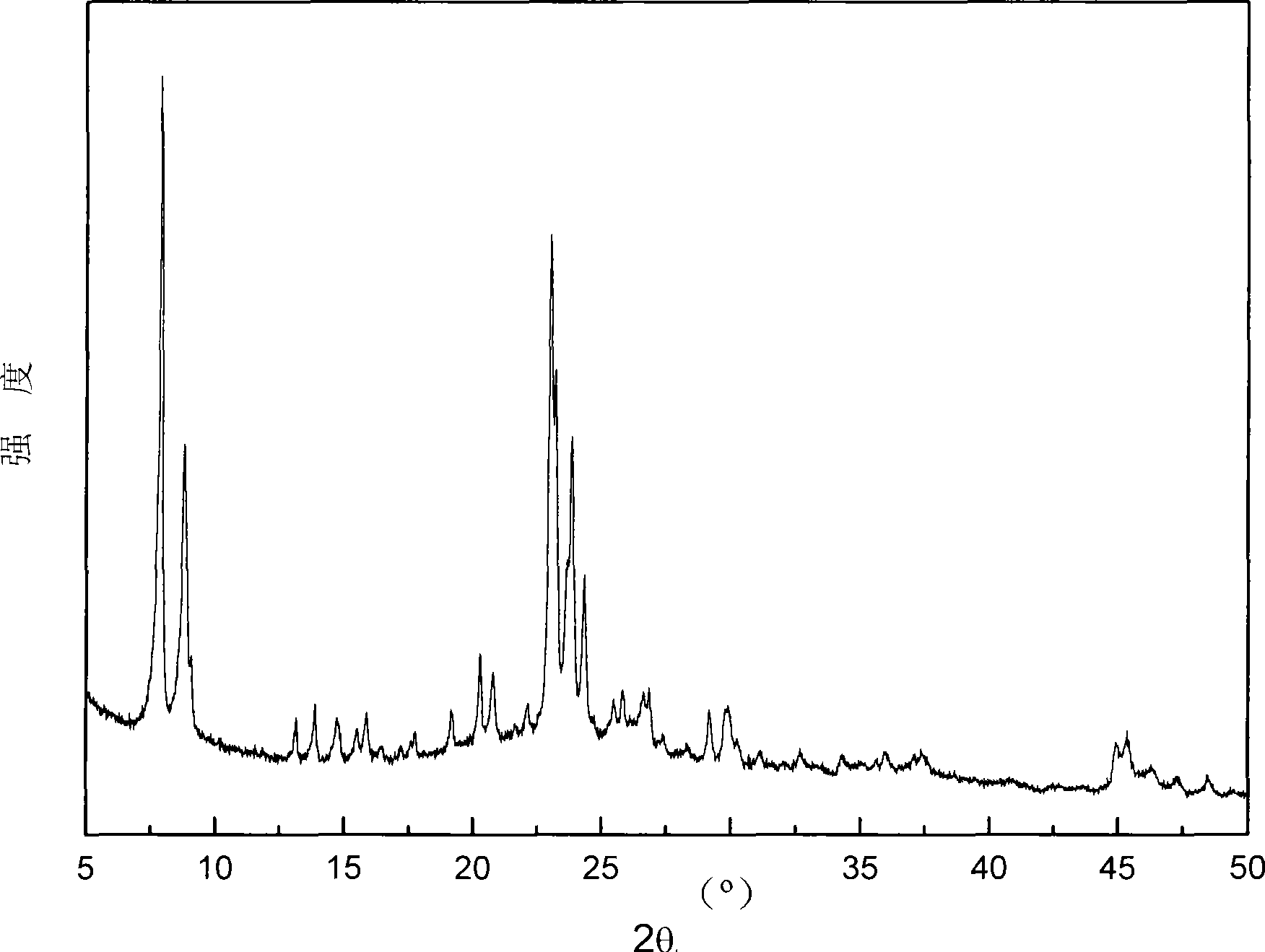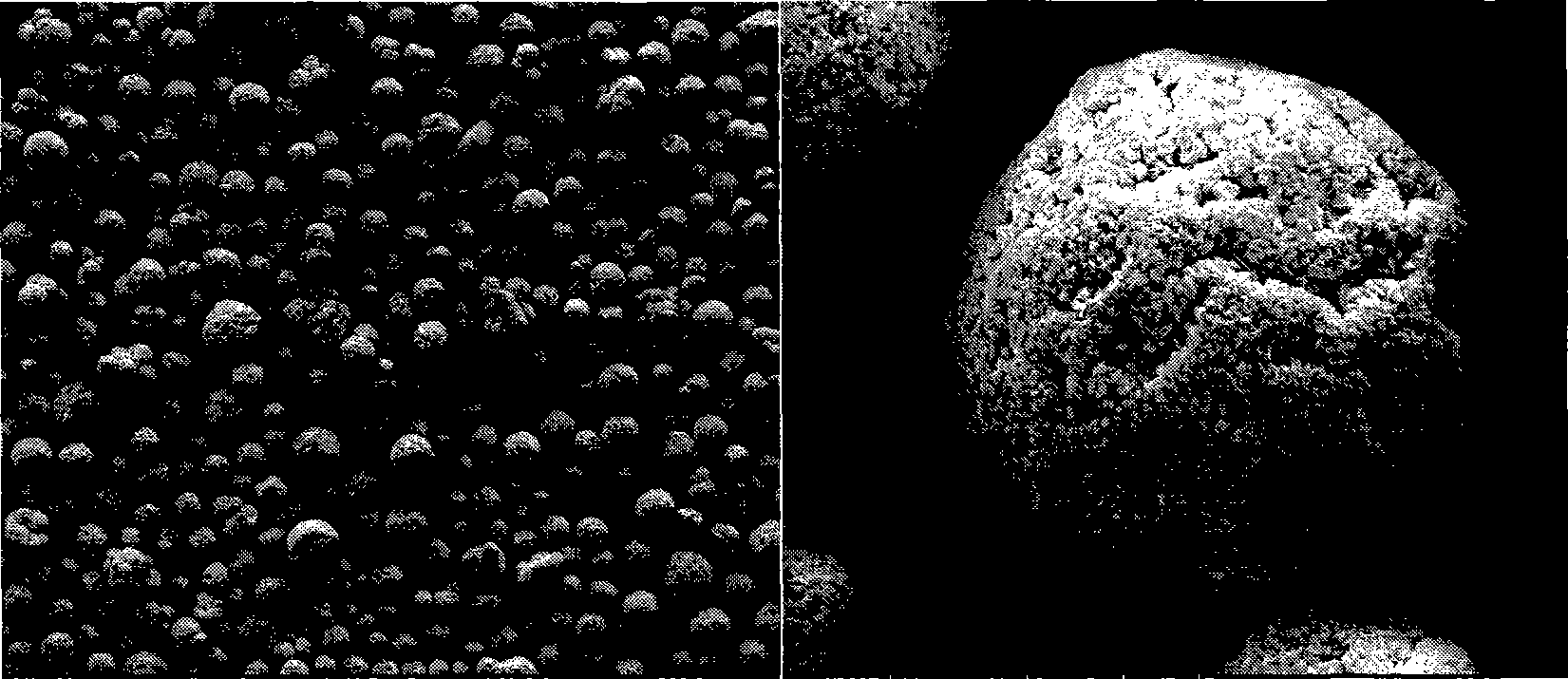Method for preparing ZSM-5 zeolite by in situ crystallization
An in-situ crystallization, ZSM-5 technology, applied in chemical instruments and methods, crystalline aluminosilicate zeolite, borocarbonane silicone crystalline aluminosilicate zeolite, etc., can solve the problem of small micropore area and micropore volume. , the method is complicated, the content of ZSM-5 zeolite is low, etc., to achieve the effect of rich mesopores, increase the volume of micropores, and high zeolite content
- Summary
- Abstract
- Description
- Claims
- Application Information
AI Technical Summary
Problems solved by technology
Method used
Image
Examples
Embodiment 1
[0039] 1. Preparation of kaolin microspheres
[0040] Add kaolin, silica sol and water into a gel tank and mix homogeneously to obtain a kaolin slurry with a solid content of 30% by weight. The kaolin slurry is spray-dried to obtain kaolin microspheres with an average particle diameter of 50 μm. The kaolin microspheres were washed twice with decationized water of pH=2-4 at a mass ratio of 10:1 to the kaolin microspheres. The properties of raw materials are shown in Table 1, and the composition content of each component in the slurry is calculated on a dry basis in Table 2.
[0041] Table 1
[0042]
[0043] Table 2
[0044]
[0045] 2. Preparation of silica-rich clay microspheres
[0046] The silicon-rich clay is diatomaceous earth. In addition, diatomite, silica sol and water were added to another gel-forming tank and mixed homogeneously to obtain a silicon-rich clay slurry with a solid content of 60% by weight. The silicon-rich clay slurry was spray-dried to obtain...
Embodiment 2
[0054] 1. Preparation of kaolin microspheres
[0055] Add kaolin, ZSM-5 zeolite seed crystals, silica sol and water into a glue tank and mix homogeneously to obtain a kaolin slurry with a solid content of 40% by weight. The kaolin slurry is spray-dried to obtain kaolin microspheres with an average particle diameter of 60 μm. The kaolin microspheres were washed twice with decationized water of pH=2-4 at a mass ratio of 10:1 to the kaolin microspheres. The properties of raw materials are shown in Table 1, and the composition content of each component in the slurry is calculated on a dry basis in Table 2.
[0056] 2. Preparation of silica-rich clay microspheres
[0057] The silicon-rich clay uses diatomaceous earth and pyrophyllite. In addition, diatomite, pyrophyllite, silica sol and water were added into another gel-forming tank and mixed homogeneously to obtain a silicon-rich clay slurry with a solid content of 50% by weight. The silicon-rich clay slurry was spray-dried to o...
Embodiment 3
[0065] 1. Preparation of kaolin microspheres
[0066] Add kaolin, Y-type zeolite seed crystals, silica sol and water into a gel tank and mix homogeneously to obtain a kaolin slurry with a solid content of 30% by weight. The kaolin slurry is spray-dried to obtain kaolin microspheres with an average particle diameter of 80 μm. The kaolin microspheres were washed twice with decationized water of pH=2-4 at a mass ratio of 10:1 to the kaolin microspheres. The properties of raw materials are shown in Table 1, and the composition content of each component in the slurry is calculated on a dry basis in Table 2.
[0067] 2. Preparation of silica-rich clay microspheres
[0068] The silicon-rich clay is bentonite. Add bentonite, water glass and water to another gel-forming tank and mix homogeneously to obtain a silicon-rich clay slurry with a solid content of 30% by weight. Spray-dry the silicon-rich clay slurry to obtain a silicon-rich clay microparticle with an average particle diameter...
PUM
| Property | Measurement | Unit |
|---|---|---|
| Average particle diameter | aaaaa | aaaaa |
| Average particle diameter | aaaaa | aaaaa |
| Average particle diameter | aaaaa | aaaaa |
Abstract
Description
Claims
Application Information
 Login to View More
Login to View More - R&D
- Intellectual Property
- Life Sciences
- Materials
- Tech Scout
- Unparalleled Data Quality
- Higher Quality Content
- 60% Fewer Hallucinations
Browse by: Latest US Patents, China's latest patents, Technical Efficacy Thesaurus, Application Domain, Technology Topic, Popular Technical Reports.
© 2025 PatSnap. All rights reserved.Legal|Privacy policy|Modern Slavery Act Transparency Statement|Sitemap|About US| Contact US: help@patsnap.com



